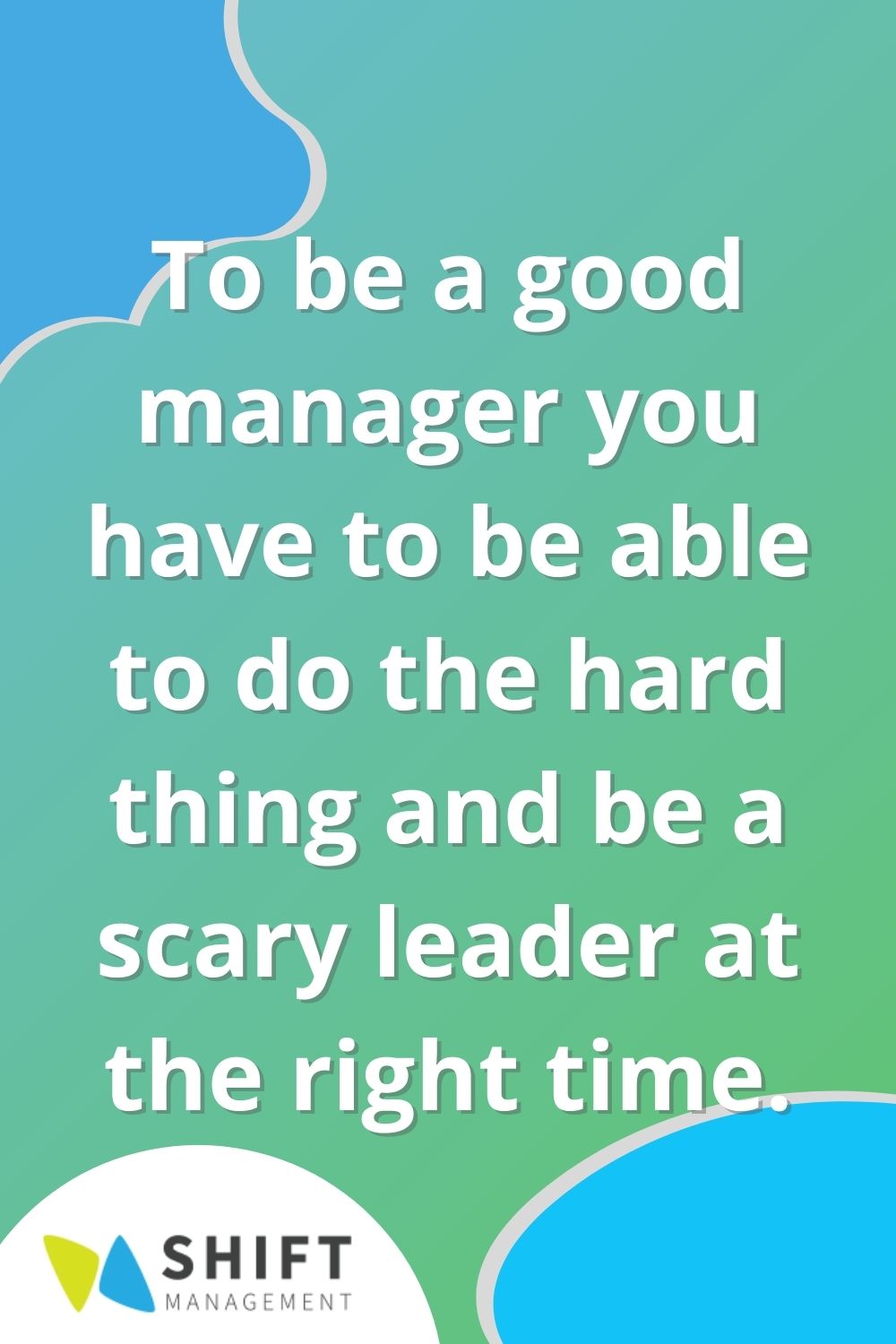Lots of people come to me with their workplace issues and management dilemmas. I listen patiently and help them come to a few conclusions about their next steps. Upon reflection, I would say that 99% of the managers seeking my advice have problems because they have an image of themselves as “nice” people. Whenever they have to do something that isn’t pleasant or requires a correction, they feel like they are betraying their “nice manager” selves. And it creates huge problems for their teams.
I’m very much in favour of doing everything possible to include, educate and upskill staff. And I’m even more in favour of having a system for workplace learning that is part of the business model. But when things get tough, it takes some courage to set limits, tell people they are off-task or out of line, and get them working on a plan to either improve or exit if expectations aren’t being met.
To be a good manager you have to be able to do the hard thing and be a scary leader at the right time. Share on X
Part of a leader’s role is to protect their group, and if you refuse to step up and enforce expectations, you are letting down your team and making it vulnerable to all the zombies and werewolves vying to come in and attack – instead of fortifying weaknesses, you are inadvertently dismantling your defenses.
But take heart, to costume appropriately for this role, you don’t have to disguise the “nice manager” inside you. Getting in touch with your inner “scary leader” is as simple as implementing a few of my favourite strategies below – you’ll be surprised how great “nice manager” and “scary leader” look together.

1. Set your expectations – prevention
If you don’t know what you want, how you want your team to act and what your values are, the team is likely to be in bad shape. Additionally, if you know what you want but you haven’t communicated it to anyone, remember that most people aren’t mind readers. Your team needs to hear and understand what you want them to hold on to, to strive for and the principles or standards you expect to be standard operating procedures. Share on X Then, they need to see the “how to” in implementing your vision, ideally first from watching you.
Because setting expectations is your first line of defense, let’s look at a couple sample statements that clarify what you need to see from the people on your team:
“I expect my team to come to me when they have an issue with another person, but ONLY after they have tried to address it with that person. If you have a problem, don’t go around gossiping about it. Go to the source and if the source is not receptive, go to the right authority, in this case me.”
Why it works:
- The procedure to address conflict with colleagues is stated simply and completely
- The manager emphasizes the behavior that s/he wants to see AND defines the behavior that is unacceptable
- By confronting the issue head on, the manager lets the team know that s/he is aware of the issues they are working with in the group. This kind of “with-it-ness” helps a group become more accountable for its behavior and results
“We will each take a day for being the first one to open the shop. The first arrival is responsible for shoveling the snow off the steps, unlocking the customer door and putting on the coffee. The last one to leave checks that all the trucks have been loaded for the next morning, turns off the lights and locks the door. Who wants Monday?”
Why it works:
- Equality, or the fact that every person is expected to meet the same responsibilities, is a key component of organizational justice. When responsibilities are shared equally across a group – that is that everyone gets a turn doing the same job in a set rotation – group cohesion can increase as a result. In this way, when a manager outlines an expectation of shared ownership in a task, the expectation can act to unify group members
- Specific task descriptions are outlined, so team members know exactly what they need to do in order to meet expectations successfully
- The manager asks for a volunteer to begin the process. At times employees can be reluctant to accept an expectation that they have not had opportunity to contribute to, but as any manager knows, group consensus is not always feasible to attain. By giving employees a choice over some element of the expectation, in this case scheduling, the manager enables a level of voluntary consent that can increase employee commitment to achieving the expectation
When you are stating your values, look to our next suggestions to help. But a word of warning: if you state a value, make sure you LIVE IT or the effect will backfire. Hypocrisy-attribution bias, or the belief that management says one thing and then does another, is a plague that will sicken any corporate culture. Immunize your group by walking your talk, especially when times are challenging.
“The thing that matters most to me is willingness to help out. People who have an attitude of helpfulness are going to be the best team members in every situation hands down.”
“What I care about is working an honest day’s work for an honest day’s pay. That means you don’t try to cheat the company out of time because you don’t feel like working. Nobody owes you salary unless you do the work. I value and appreciate honest employees who put in a full day’s work. ”
Why these work:
- The expectation is related back to a broader value description – in these cases helpfulness and honesty. Most people regardless of religion, cultural background, or political belief will not dispute that core values such as these (consider also respect, compassion, integrity) are valuable in and of themselves
- When people understand WHY they are expected to behave in certain ways, it helps gain compliance
And finally a few examples on how to say what behaviours you expect:
“Our team huddles are an important time for us to check in with each other and assess the progress of projects. We need everyone’s contribution, and that starts with engagement. During our team huddles I expect everyone to be standing, no leaning – look like you are willing to listen and contribute, and do not check your phone. Every person is responsible to say one helpful comment or check in on progress for one of our tasks.”
Why it works:
- The manager explains the main goal of the activity (to check in with each other and assess progress)
- Team members are invited to fully contribute and the behaviours expected to achieve full contribution are clearly outlined
- A clear time is set (during each meeting) when employees are expected to deliver on expectations. People need to know not only the WHAT and HOW around an expectation, they also need to know the WHEN
“When a customer comes in for an audit, I expect you to greet the customer and shake his or her hand, smile and say your name. We want to be known as a people company and everyone’s attitude affects what our customers think about us.”
Why it works:
- The expectation is related back to a corporate value
- When the manager uses “We want to be known…” s/he includes the employee in this statement as a valuable contributor to the company’s overall reputation. If the manager had said, “I want this company to be known as a people company,” or something of the like, the employee perceives that s/he is an outsider within the organization – a quick way to de-motivate anyone

It is not sufficient to set expectations once and then think everyone will just do them. I suggest reviewing your expectations or some aspect of them at EVERY staff meeting.
Wait a minute, did you say you aren’t having any staff meetings? Don’t worry – they don’t have to be long. You can have a 10 minute standing meeting, a 5 minute daily recap or a weekly check in on project deadlines, but meet you must or people will get sloppy on the expectations end. Figure out what you can make work, and then be regular about it.
2. Ask people what they need to feel safe and respected – prevention
It is always amazing to me how freely people talk when I ask them this question. When you ask your group, start by answering it yourself – the leader needs to take the first risk to show the others it is safe. Make sure you go around the group with only one person at a time, in order, answering the question and don’t allow any side comments – the other team members need to listen in silence. If a person isn’t ready to speak, say you will come back to them at the end, and then do it.
Once everyone has spoken, ask the group to remember what was said by their colleagues and ask them to take it to heart. Use the THINK acronym – as in “think before you speak” – to finish the discussion about feeling safe and respected at work (hint: it makes a nice poster):

Remember to check in a couple of times to make sure individuals feel respected and safe. If things go off track you may need to do this again. People tend to autocorrect their behaviour once they know what is expected of them.
3. Get the team on board with everyone being accountable for their contributions to the group – prevention
This is generally best done in a meeting format, but you can also do it one-on-one if there are issues on a team and people are unlikely to speak freely. Here are the main steps:
- Ask the team what bad teamwork looks like – get some examples and keep a list
- Ask the team what good team work looks like – get some examples and keep a list
- Ask what obstacles are in the way of getting to the good teamwork picture – this takes some honesty from the team members and you have to be willing to hear it and to protect people from any personal attacks. Get everyone to phrase their comments in terms of “When this happens, it is an obstacle to good team work”
- Ask for personal commitment to one of the good teamwork behaviours that the group can agree on and get each person to describe what their commitment will look like
- Test it for one week and get feedback from everyone on what they noticed
- Congratulate the team on any progress so they feel validated
Remember that building a team takes a lot of baby steps in the beginning so don’t discourage people, rather encourage their first tentative efforts.
4. Nip the first bad behaviours in the bud before they grow or spread – correction
Even when you have established a capacity-building team climate and are checking to make sure it is continuously improving, you will still have individuals who are not doing what they should or who are critical, negative or intimidating.
When you FIRST see this behaviour in an individual, speak to the person about it privately and say how this behaviour affects you. Ask if that was the intention. Leave it at that for a first meeting. People can think about things for a bit and let them sink in.
If you have to speak to the individual again, ask what the individual will do to ensure this behaviour stops and create a written, signed plan that focuses on ONE behaviour change – trying to track several behaviour changes will not be effective. Clearly say that not following through will result in a consequence and get agreement that the individual knows what that consequence will be. They do not have to agree with the consequence, just have to agree that they know what the consequence will be. Explain to the person, that you will be recording this as a demerit in the individual’s file.
A third time means you administer the consequence. And if there is a fourth time, it is grounds for dismissal. If you are in a unionized environment, you can do this within the three month probation period. If the person is past that period, you will need to negotiate your action plan with the union in advance and get buy-in.
Acting quickly and following this kind of progressive discipline plan is important. One employee’s bad behaviour can make staff morale go down, which makes productivity go down, which makes profit go down, and now you have an unhappy workforce that bad mouths you and the company.
So do the hard thing the FIRST time you notice an issue, monitor it over a SHORT period of time for correction. Stop thinking that “education” will change someone who is not motivated to change. You can only educate people with the right attitude, and if they aren’t willing to put on the mantle of learning, collaboration, team support and continuous improvement, well – you can lead a horse to water but you can’t make him drink.
If you are worried you won’t have the personal strength of character to do this on your own or that it will backfire, do it with a colleague, HR manager or other authority AFTER creating a plan with that support person together and documenting it.
5. Use the power of the group to bring difficult people into the circle

If you have a staff person who is not performing or who is making life difficult for the others AND your previous attempts to address the behavior have not been effective, here is another strategy. First tell a colleague, or decision maker that you want him or her to be present at a difficult meeting and that the meeting results will need to be documented. Make sure that colleague is willing, understands the situation, will support you, knows he or she is there as an observer for witness purposes.
Then at the specified meeting where you, the observer, the difficult person and team members are present, name the elephant in the room by saying to everyone that there is an issue (name one issue very clearly) with (name the person) and that this has become a team problem the team because (state reason). Say that this is something the group is going to jointly solve. Then explain and use this process:
- Explain that the person who is difficult is not allowed to speak until the end of the first and second round
- Give everyone a turn to explain how the person’s behaviour affects them, but they must phrase the comment in a way that is both honest and kind
- Have the “accused” respond, explaining that s/he is not allowed to “defend” him or herself; there is just a response to the group
- Round two begins and the difficult person returns to ONLY listening
- Invite everyone to offer comments that MUST be focused on one helpful strategy the “accused” could use to remedy the problem
- Have the difficult individual choose one suggestion or invite them to come up with one on his or her own – again, no defensiveness, just choose a strategy
- Set a timeline for the difficult individual to try out the strategy. Explain that there will be follow-up on an individual level
- End the meeting by saying that you value the team member who has been under fire, acknowledge that this is a difficult process and that it takes maturity to work through, however stay firm on the fact that the behaviour has to be addressed. Remind everyone that this is confidential and that nothing from this meeting is to be discussed outside of the meeting under any circumstances. Then thank everyone for being honest and kind and go back to work
- Document the results and the dates, and follow up individually with each team member as well as the difficult individual in a week to see if there have been improvements
Even very thorny problems can be solved with this approach: people will adjust when they feel the entire team is working on the issue and when they see that avoiding the situation is not an option. It is team pressure in a positive sense.
BUT, there are two caveats to this approach. The first one is that you HAVE to have the trust of the team and the support of an administrator to attempt it. Second, if the individual has a mental illness or an addiction, do NOT attempt this kind of intervention. Rather, refer the person to another authority with a written report containing documented behaviours.
Creating a framework
We are all working together; that's the secret ~ Sam Walton Share on X
In summary, the best way to build the climate for a healthy team will always be to get specific and conscious about the strategies you use. When you are willing to address the hard things with your “scary manager” self, what you are really doing is providing a framework of safety that will uphold all the effort your “nice manager” self has worked so hard to create. More, you are creating the kind of structure that enables your team and organization to progress.
So, choose which strategy you want to implement today: start communicating clear expectations, ask your employees what they need to feel safe, get your team onboard, nip bad behaviours in the bud early on, or use the power of the group to help change others’ behaviour. Start today and get others’ to support you as you do.
Go ahead and channel that inner “scary leader” – your nice leader will thank you for it!
If we aren't going to be afraid of conflict, we have to see it as thinking. ~ Margaret Hefferman Share on X
People who read this article also read…
Courageous conversations you wish you’d had
Three Things Your Supervisors Are Doing Wrong And How To Fix Them
About Marie:
Marie Gervais, PhD., CEO of Shift Management Inc., provides managerial training and workforce interpersonal development to business and industry through online courses and web coaching. She helps individuals and organizations build talent and skills for leadership, communication, and conflict resolution particularly at the supervisory and middle management level. Her work has gained a reputation for excellence in integration and inclusion of the diverse workforce. With her team at Shift Management, Dr Gervais helps clients reach their business goals through team building coaching and industry-specific training development for interpersonal leadership skills. Her impactful digital and multi-media resources have been successfully implemented with many different populations and contexts. The results prove that a learning workplace is a happy and profitable one!
Check out Marie’s podcast Culture and Leadership Connections on Apple Podcasts and on the Shift website to hear stories of leadership and all things cultural. Consider the signature Supervisory Leadership Certificate Course for upskilling your workforce at:
https://shiftworkplace.com/courses/supervisory-leadership/
Contact information:
780 993 1062








